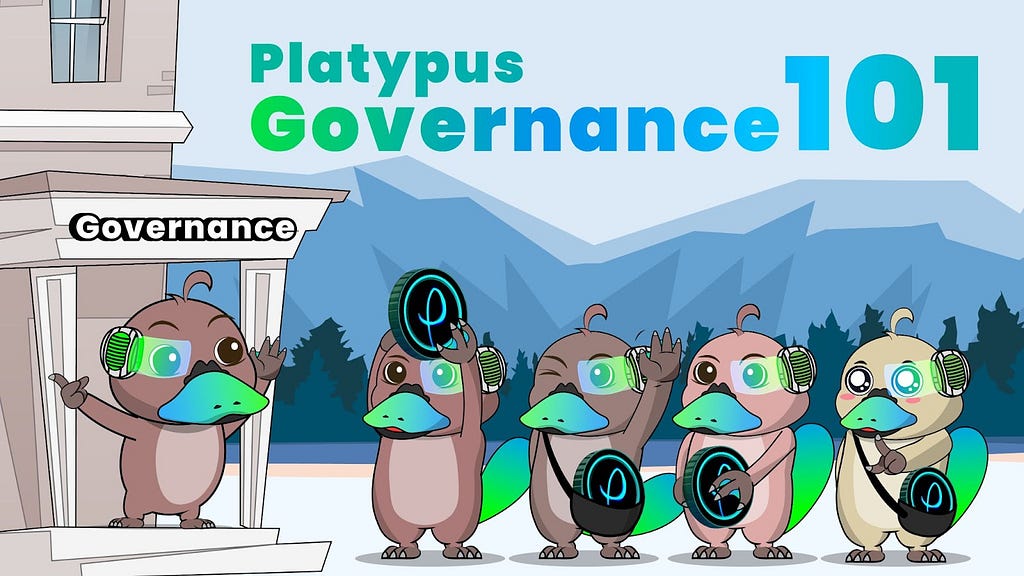Platypus Governance: A Comprehensive Guide
Join us on an exciting journey through the intricate and fascinating world of Platypus governance. This article is your guide to understanding everything there is to know about how Platypus’s governance system works.

At Platypus, we believe in the power of community-led decision-making and we’re moving towards a decentralized governance protocol. We’ve always wanted to shift towards a more democratic approach to promote transparency, trust-building, and active participation from users and investors in shaping the protocol’s direction. Through decentralized governance, everyone gets a voice and can see how decisions are made.
TL;DR
- vePTP holders have governance power tied to their vePTP balance in Platypus’s PTP governance framework.
- There are two major parts of the governance process, Temperature Check and Consensus Check.
- Various types of proposals can be submitted for consideration in Platypus governance, such as adding a token to a pool, creating a pool for given tokens, adjusting haircut for pools, adjusting protocol parameters, and proposing new features.
- When proposals move to Snapshot, all vePTP holders can deliberate and decide on the outcome by voting according to their vePTP weights.
Join us on a journey as we unveil our governance process, a path that has been paved with simplicity and ease to guide you every step of the way.
But first, familiarize yourself with the platforms you’ll be interacting with that will allow you to engage in discussions and share your ideas with the community.
Discourse Forum:
Our hub for idea sharing and discussion. Join the conversation and make your voice heard! To post your own ideas, make sure to read at least 30 posts, spend 10 minutes reading, and participate in at least 5 topics.
Snapshot:
This is where the real action happens! Snapshot enables off-chain voting, weighted by the number of vePTP. Although only the Platypus team can submit a proposal on Snapshot, we’re always open to community suggestions. If your proposal passes the Temperature Check, contact the Platypus team by mentioning @admins in your post reply, and we’ll create a snapshot poll for you.
Creating a proposal
Temperature Check
If you are ready to make some changes, start by checking if there is enough will in the community to bring your idea to life. Here’s how:
- Post your proposal in the Temperature Check category on Discourse and make sure to label it as “Temperature Check — [Your Title Here]”
- Use the Proposal Structure format and invite other community members to join in on the discussion.
- Community members can show their support by giving likes and commenting. If your post receives at least 15 votes, you’ll move on to Consensus Check.
Consensus Check
In this step, the discussion gets formal, and we aim to reach a consensus. Here’s how you can perform a consensus check:
- Use the feedback you received in the Temperature Check post to improve your proposal. To alert the community, create a new post in the Consensus Check category titled “PIP # — [Your Title Here]” and link it to the discussion thread.
- Contact an admin to create a new Snapshot poll by mentioning @admins in your post reply. It is important to provide the following information in your post reply: The Proposal content, Relevant links, Temperature Check thread and Consensus Check thread.
- The poll will last for seven days. Make sure you have added the snapshot poll URL to your Consensus Check thread.
- Stay neutral and respond to any questions or concerns community members have.
The option with the majority of votes wins, and a vePTP yes-vote quorum of 30m and over 50% yes-votes are required for consensus. A one-day timelock is implemented before executing the proposal that passed the consensus test.
If the “Make no change” option wins, the Consensus Check topic will be closed by the admins/moderators.
To resubmit the proposal, a 7-day cool-down period is required. During this time, revisions should be made based on the previous feedback provided by the community.
Our governance forum is the perfect platform for you to share your thoughts, opinions, and ideas. Whether you want to propose a new project, suggest a change, or simply engage in discussions about the future of Platypus, there are endless possibilities.
Types of Proposals
There are various types of proposals that can be submitted for consideration in our governance. And these are proposals for:
- Adding a token to a pool
- Creating a pool for given tokens
- Adjusting haircut for pools
- Adjusting protocol parameters
- New features
Proposal Structure
We love to hear from our community members and we encourage you to submit your proposals for discussion and feedback on the forum. But before you hit that “Post” button, make sure to include the following components in your proposal, listed below in a specific order. This will make it easier for everyone to follow and provide constructive feedback.
Abstract: Start with a snappy summary of your proposal that gets people excited about your idea. Think of it as your elevator pitch — it should be brief, but persuasive.
Motivation: Here’s where you can really let your creative juices flow. Provide detailed explanations that are informative and specific to your proposal. Show how it could benefit Platypus and the community, and address any potential challenges that may arise. Remember, the more well-thought-out and persuasive your proposal is, the more likely it is to garner support.
Next Steps: Don’t leave people hanging! After the Temperature Check is passed, let everyone know what will happen next. If there’s a Snapshot link or any other resources that people need to know about, provide those details here.
References: If you want to really pack a punch with your proposal, include references that support your arguments. Cite other successful projects, relevant research, or anything else that can add credibility to your proposal.
Passing Temperature Check and Consensus Check
To successfully make a change on Platypus, it is crucial to pass both the temperature check and consensus check.
Temperature check
- The proposal needs to gain enough traction by receiving at least 15 votes in the post
- The discussion will last for two days.
Consensus check
- The consensus check involves a formal discussion on the proposal, where feedback from the temperature check post is considered, and the proposal is adjusted accordingly.
- A Snapshot poll is then created, and the vote lasts for seven days.
- There needs to be a 30M vePTP yes-vote quorum and more than 50% yes-vote.
- There is a one-hour delay between the voting period and the day of execution.
Closing Remarks
Platypus governance system is designed to promote transparency, trust-building, and active participation from users and investors in shaping the protocol’s direction. If you want to participate in the governance system, simply join the discourse forum and follow the steps laid down in this article. We believe in community-led decision-making and aim to move towards a more democratic approach.
Follow Platypus
Discord | Twitter |Telegram | Instagram
Platypus Governance: A Comprehensive Guide was originally published in Platypus.finance on Medium, where people are continuing the conversation by highlighting and responding to this story.


